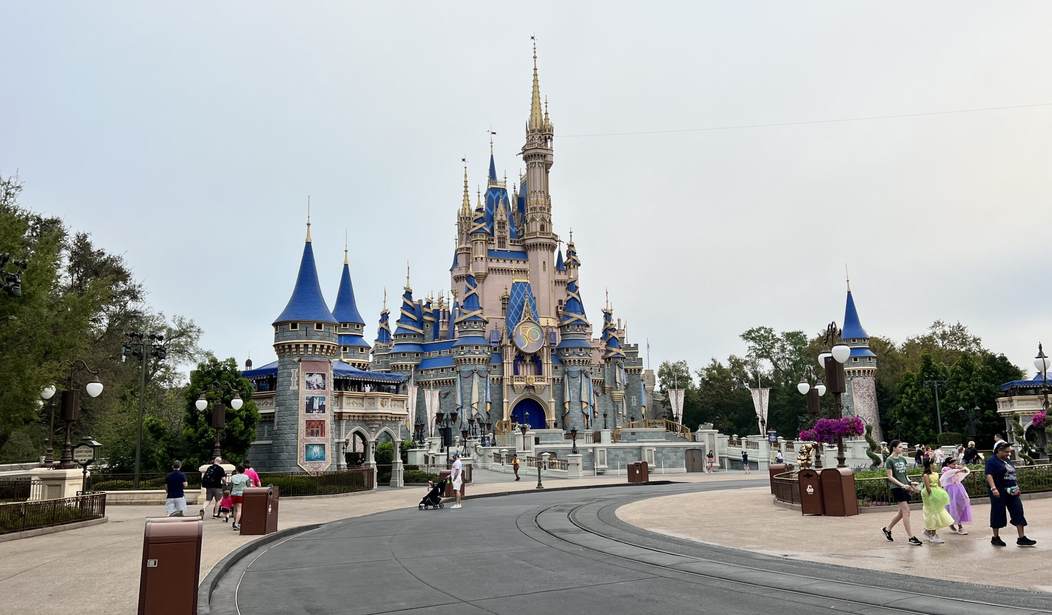If you’ve read much of my writing, you know that I consider myself an expert on Disney — not in the way that leftists who think you should wear masks in perpetuity are “experts” on pandemics, but a genuine expert. Disney has been part of my family life from the beginning. My parents honeymooned at Walt Disney World just months after it opened, and my siblings and I (and later my nieces) grew up on Disney movies and TV shows.
Disney’s woke content and political meddling in Florida hurt us as a family. We’re not boycotters by nature, so even though we haven’t quit Disney like some people, we’ve backed off on our trips to Walt Disney World at least for the time being, and we’re not fans of some of the new content that Disney is putting out.
But there are some other problems that have nothing to do with politics that hit my family and other dyed-in-the-wool Disney fans where it hurts the most. I believe that they’re as responsible for the recent dip in attendance at Disney’s theme parks as much as — if not more than — any political backlash.
The first reason is purely financial. To put it bluntly, a Disney vacation is getting increasingly expensive. National Review’s Jim Geraghty wrote an article earlier this week that exposed the ridiculous increase in theme park ticket prices over the years. He explained:
The current ticket prices for Walt Disney World and its related theme parks are as follows:
- Disney’s Animal Kingdom: $109-$159
- Disney’s Hollywood Studios: $124-$179
- EPCOT: $114-$179
- Magic Kingdom: $124-$189
There are ranges because Disney has holiday prices, peak-day prices, regular prices, and value prices, depending upon the day.
Compare this to historical prices for the Magic Kingdom:
By comparison, in 2013, a ticket to the Magic Kingdom was $95. Adjusted for inflation, that is the equivalent of $125.46 today. (Inflation-adjusted prices were generated using the Bureau of Labor Statistics inflation calculator.)
In 2003, a ticket to the Magic Kingdom was $52. Adjusted for inflation, that is the equivalent of $87.04 today.
In 1993, a ticket to the Magic Kingdom was $35. Adjusted for inflation, that is the equivalent of $74.65 today.
In 1983, a ticket to the Magic Kingdom was $17. Adjusted for inflation, that is the equivalent of $52.86 today.
And that’s just ticket prices. Consider food, souvenirs, resort, and parking prices — all of which have gone up tremendously — and you can see how Disney is pricing out many hardworking families.
Related: Bob Iger Walks a Tightrope When It Comes to Florida
The other problem that Disney has relates to trip planning. Over the past few years, the company has employed a growing set of “planning tools” that are increasingly complex and decreasingly user-friendly. Oh, and some of those tools add to the financial burden on guests.
One former Imagineer has taken notice. The New York Post reports that former Imagineer Ryan Harmon has weighed in on the fact that Disney has taken all the spontaneity out of a trip to the parks.
The popularity of Disney’s offerings has led the company to add more attractions and events. “That’s why they’ve added many more experiences, they try to raise the price high enough,” Harmon said. “That maybe weeds out some people, but that doesn’t seem to work, and so they’ve come up with a system using your mobile phone…the problem is that unless you plan ahead — which a lot of people do not — you end up going there and having a pretty poor experience because people have reserved rides and shows and restaurants.”
Harmon related a story of taking his team on a spur-of-the-moment trip to Walt Disney World, and his party wasn’t able to do much in the Magic Kingdom because so many of the experiences were booked solid. The experience was so bad that they only stayed in the park for two hours.
“We bought our very expensive tickets and went in and watched as all these people walked in front of us in the queues because they made an online reservation,” he said. “So we got stuck waiting and waiting and waiting.”
Harmon made a brilliant suggestion: that Disney cap the number of reservations in a day to allow more spontaneity. Putting a lid on reservations would allow guests to walk on rides and attractions more easily.
“I think they really need to take a step back, reconsider what the guest experience has become, and find a way to make it democratic and fun again, and far less time spent on your phone,” Harmon said. “That’s not what it’s about.”
Disney’s new Lightning Lane feature, which replaced the free FastPass system, adds an additional charge for guests to skip at least part of a ride queue. The cost for Lightling Lane fluctuates with demand, while some newer attractions are Lightning Lane-only. On peak days, Lighting Lane reservations for one attraction can cost as much as $15 per guest. Needless to say, this is where the two problems meet head-on.
This goes beyond “go woke; go broke.” It’s more along the lines of “make bad decisions; go broke.” Disney needs to get a handle on these two issues if they don’t want to lose or alienate more guests. As a lifelong Disney fan, I hope it’s not too late.










Join the conversation as a VIP Member